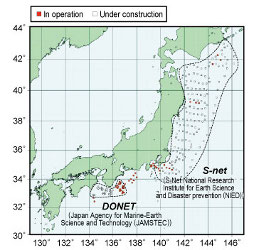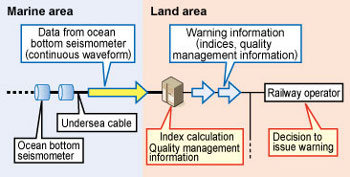3. Early warning system employing ocean bottom seismometer data
Japan is currently expanding its ocean bottom seismometer OBS) network (Figure 1). Data about earthquakes occurred beneath the sea collected through this network is used for issuing early earthquake warnings, which can be useful for railway earthquake disaster prevention. As such a method was designed to employ OBS data in early warnings, while telecommunication specifications and quality management technology were developed to maintain early warning reliability.
In the proposed method the OBS data sent to land observation stations through undersea cables is used to calculate the indicators which will determine whether a warning should be issued or not. The data is sent via telecommunication networks to the railway operators together with other information which indicates the quality of the data. While taking into account data quality, railway operators then issue a warning if the indicators exceed the regulatory threshold value (Figure 2).
Technology was then developed which immediately calculates data quality information based on waveform observation which indicates missing data, noise, etc. to ensure warning reliability, and which railway operators can refer to when deciding whether to issue a warning or not (Table 1).
To enable multiple railway operators to share the submarine seismographic data telecommunication specifications were subsequently defined to enable transmission of data through a limited frequency band telecommunications line.
It is expected that using OBS data should increase the spare warning time for earthquakes by approximately 20 seconds at most.
Other Contents
- 1. Seismic ground motion simulator applicable to M9 earthquakes
- 2. Seismic Hazard simulator for railways
- 3. Early warning system employing ocean bottom seismometer data
- 4. Development of Railway Embankment Structures Resistant to severe Earthquakes and Prolonged Overflows caused by Tsunamis
- 5. Measures against buckling of ballasted track during earthquakes
- 6. Disaster Hazard Mapping Technology
- 7. Method for diagnosing condition of concrete roadbed in tunnels
- 8. Analytical method for evaluating carbody safety aimed at reducing passenger injury in case of level crossing collisions
- 9. Bogie to control decrement in wheel load
- 10. Mechanical pneumatic steering system with failsafe function
- 11. Gear oil for Shinkansen trains with improved startability in low temperature conditions
- 12. Process to select appropriate sounds to convey in-cab driver alerts
- 13. Training in communication techniques for train dispatchers in disrupted situations
- 1. Seismic ground motion simulator applicable to M9 earthquakes
- 2. Seismic Hazard simulator for railways
- 3. Early warning system employing ocean bottom seismometer data
- 4. Development of Railway Embankment Structures Resistant to severe Earthquakes and Prolonged Overflows caused by Tsunamis
- 5. Measures against buckling of ballasted track during earthquakes
- 6. Disaster Hazard Mapping Technology
- 7. Method for diagnosing condition of concrete roadbed in tunnels
- 8. Analytical method for evaluating carbody safety aimed at reducing passenger injury in case of level crossing collisions
- 9. Bogie to control decrement in wheel load
- 10. Mechanical pneumatic steering system with failsafe function
- 11. Gear oil for Shinkansen trains with improved startability in low temperature conditions
- 12. Process to select appropriate sounds to convey in-cab driver alerts
- 13. Training in communication techniques for train dispatchers in disrupted situations



